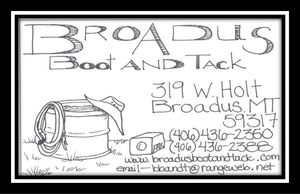The Preliminary Trial of Ray Tarbell
March 26, 2020
A local history column, written by Historian Shane Dunning. Shane may be reached at [email protected].
In 1909, newspapers such as the The Sheridan Post called it “the question of the range.” It was a euphemism for the political, economic, and cultural conflicts that resulted from the decades-old Federal land policy usually referred to as “open range.” In Powder River country, that question of the range often turned violent in ways the local legal systems seemed unable (or unwilling) to address. In 1900, sheepmen John Daut and R.R. Selway had over 2,000 head of ewe lambs clubbed to death in a single night by eleven masked vigilantes. Selway’s later attempt to bring those he felt responsible to justice through the law failed miserably. In 1901, Hank Greenway found a whitecap message saying he would “need a coffin” if he brought his sheep to Powder River. Events such as these demonstrated that any small livestock operation in the Yellowstone Valley that depended on open range could not depend on the legal system to protect their rights from an extra-legal threat. In practical terms, small operators could only ally themselves with other outfits (big or small) for mutual cooperation and security. In some cases, these extra-legal factions actually served to escalate any private tensions that occasionally resulted in tragedy. Such a case occurred on September 8, 1909, with the killing of cattleman George Mitchell by Ray Tarbell.
Tarbell had quickly surrendered himself to Custer County officials, with bail being secured by his friend and local sheepman Link Wilson. A preliminary hearing occurred on September 27th. The purpose of the preliminary hearing was to determine if the State had cause to put Tarbell on trial for murder, and the atmosphere was very tense. The prosecution was led by County DA Sharpless Walker. Ray Tarbell’s defense counsel consisted of Judge Charles H. Loud (perhaps the most distinguished lawyer in Eastern Montana) and his partner Donald Campbell. Justice of the Peace John Gibb presided over the proceedings.
It is the nature of preliminary hearings that the defense counsel does not present a full-throated defense unless the evidence is overwhelming enough in favor of their client to result in a dismissal. In this case, Loud and Campbell clearly understood that their client was going to full trial, and used the preliminary hearing to put the State’s witnesses on the record and only hinted at the defense they would use later at the full trial: that Ray Tarbell shot George Mitchell in self-defense. The preliminary hearing was covered closely by the local press, resulting in a tale strongly suggesting that George Mitchell had been murdered in cold blood.
The star witness of the preliminary hearing was Ray Mitchell, the son of the deceased. He was riding next to his father during much of the dispute. Also testifying for the State was Scott Mitchell, the deceased’s nephew, and four others.
On the morning of September 8th, George Mitchell and his son Ray, along with his friend Henry Jackson, rode into the sanctioned roundup then being run by the UA outfit at the mouth of Sheep Creek. This location was about a mile away from the Selway post office on Pumpkin Creek (near the present-day community of Sonnette). As they rode up, three to four hundred cattle had been collected by around a dozen cowboys. Some of these cowboys were keeping the cattle collected while others were off their horses, relaxing and waiting for the next group to be driven into the roundup. Eighteen-year-old Ray Mitchell observed what he believed to be some of his father’s cattle among the herd.
Within an hour after their arrival, the last group to move cattle to the roundup arrived. This group was being driven by Ray Tarbell, William Eubanks, and John Woodley, among others. Woodley and Tarbell were running the roundup on behalf of the UA outfit and were known associates of local pioneer rancher Link Wilson. As soon as George Mitchell was spotted, Tarbell and Woodley loped their horses aggressively in his direction, with Eubanks also heading toward the group, although along the other side of the roundup herd, arriving together in front of Mitchell. Woodley was in the lead, and as soon as he got within arms distance of Mitchell, they exchanged words about Mitchell’s intentions. Woodley suddenly pulled out a six shooter and tried to physically strike Mitchell with it. He missed, and Henry Jackson rode his horse between his friend and his attacker to separate them. Then the shooting began.
(Continued on Page 4)
By all accounts at the preliminary hearing, the only people to successfully pull out their pistols and fire during this first fight were Tarbell, Jackson, Eubank and Woodley. Tarbell apparently shot first at Jackson, possibly hitting Jackson’s horse in the leg. The horse bucked his rider off, and Jackson returned fire while on the ground, running to a flat near where he landed. Around twenty shots were fired between the four of them, with no apparent casualties. During a lull in the fighting when Tarbell, Woodley and Eubanks apparently reloaded their weapons, George Mitchell rode to Jackson’s location and, significantly, took up Jackson’s gun. He then rode back to his son and stated, “Come on and let’s go home.” With that both Mitchells turned and started away from the roundup toward their ranch.
Ray Tarbell, finished reloading, rode to catch up with the Mitchells and hollered “Hold on, I don’t want to have to shoot you in the back!” George and Ray Mitchell turned their horses and faced Tarbell. “You have made your boasts” Tarbell accused George Mitchell, who responded, “I have made no boasts”.
“You have and I can prove it”
They continued arguing while Eubanks and Ray Wilson (the son of Link Wilson) rode up. What happened next varied from witness to witness. Some say only one shot rang out. Others said they heard two shots. When it was over, George Mitchell fell off his horse, shot once through the left side of his chest, tearing his aorta and killing him almost instantly.
Ray Tarbell turned to George Mitchell’s son and ordered him to drop his gun, which he did. He then told the deceased’s son “Ray, you go on or I will kill you.” Ray Mitchell refused to leave his father and Tarbell rode off for the moment. Tarbell then ordered the roundup to continue moving, allowing Ray Mitchell and Lehman Wilkes to stay with George Mitchell’s body. After some confusion, a buggy from Mitchell’s ranch came and picked up the body.
Most of these details were provided by Ray Mitchell. Fourteen-year-old Scott Mitchell, who had been working the roundup for several days, testified that Woodley and Tarbell would not allow him to cut his uncle George Mitchell’s cattle (Scott was repping for his father, Henry Mitchell), but gave no reason for the exclusion. Three other eyewitnesses, Lehman Wilkes, John Wethers and H.W. “Bummy” Schubert, offered limited and sometimes conflicting testimony, as they were some distance from confrontation. Coroner A.R. Varco testified on the nature of Mitchell’s wound.
Tarbell did not take the stand in his own defense at this hearing. His counsel focused on the final confrontation, and whether both men fired at each other at approximately the same time. They also inquired if the State’s witnesses were aware of any threats George Mitchell had made to kill Tarbell or Woodley if they came on his range, a charge the witnesses largely denied any knowledge of. No defense witnesses were called, and Justice Gibb ordered Ray Tarbell bound for trial on a charge of first-degree murder.
This ended the preliminary hearing of Ray Tarbell, charged with killing George Mitchell. The press coverage of the one-sided nature of the preliminary hearing seemed to put Tarbell in a desperate situation. The full trial would take place that December, and the results again called into question the usefulness of the legal system in an era of faction and intimidation. Friends of George Mitchell and cattlemen seemed convinced of Tarbell’s guilt, and Mitchell’s innocence. Tarbell and Woodley’s allies, associated with Link Wilson and those who ran sheep as well as cattle, seemed to rally to his cause. George Mitchell, they whispered, was a dangerous and quarrelsome man who had previously threatened Tarbell and Woodley.
After two trials, Ray Tarbell was eventually acquitted of all charges, with witnesses on both sides completely contradicting one other, seemingly dependent on which faction they allied. The resulting bitterness was strongly felt in the area for decades. The story of the full trial and its aftermath will be told in a future article.
Author’s note: In researching this story, the files of the Custer County Court were found to be incomplete. I was only able to obtain the transcript of the preliminary hearing and some minor documents that relate to the two full trials of Ray Tarbell. During last year’s centennial, I visited with several people on many subjects, some who claimed they had a full transcript of the Ray Tarbell trial. Unfortunately, I did not write down their names and only later learned the courthouse records were incomplete. If anyone has a copy of the trial transcript, other than the preliminary hearing, I would appreciate being able to obtain a copy of it for the historical record of this fascinating event. Another note, in this article I have spelled his name as Tarbell, with two L’s. It should be noted that historically his name was spelled as “Tarbell” and “Tarbel.”










Reader Comments(0)